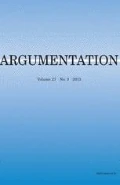Abstract
Muhammad Arsyad Al-Banjari who lived from 1710 to 1812 in Borneo, Indonesia, applied a model of integrating uses of the Banjarese tradition into Islamic Jurisprudence based on a dialectical constitution of qiyās, the legal argumentation theory for parallel reasoning and analogy, he learned from the Shāfi‘ī-school of jurisprudence (uṣūl al-fiqh). Our paper focuses in the model of integration proposed and practiced by Al-Banjari, a rational debate grounded on a dynamic view on legal systems. We will illustrate the method with the help of two different kinds of qiyās deployed by Al-Banjari in order to argue for the rejection of some traditional Banjarese offering-rituals for avoiding disease or calamities (manyanggar and mambuang pasilih), and for the acceptance of the use of consuming the traditional drink called lahang made of the juice of sugar-palm. As our dialogical reconstruction shows, the development of the debates, particularly the first one, is quite sophisticated, with a Banjarese opponent that does not surrender easily to the rejection of his use of those rituals.
Similar content being viewed by others
Notes
In relation to Islamization of Indonesia, see Kersten (2017).
The Banjarese is the native ethnic group in South Kalimantan. They represent one of the largest tribe in Indonesia. Nowadays they are more than 4 million, mostly living in South Kalimantan. The Banjarese have the reputation of being pious Muslims. Islam became constitutive of their identity – see Hawkins (2000) and Chalmers (2007).
That is, the principle that “the original state of things is permissibility except for what the Law proscribes” (al-aṣl fi’l-ashyā’ al-ibāḥa illā mā ḥaẓarahu al-Sharʿ). See Ibn Ḥazm (1928–1933, vol. 1, p. 177). See Rahman/Zidani/Young (2019b, section V).
Whereas al-Ghazālī defended vehemently the use of qiyās, he did not share the opinion that the occasioning factor can be identified by pure epistemological means. Epistemological methods must be coupled with insights coming from additional hermeneutical procedures. Cf. al-Ghazālī (1324H, pp. 307–308) and Hallaq (1987b, pp. 61–62).This seems to be the interpretation of al-Ghazālī' followed by Al-Banjari. Perhaps, one way to put al-Ghazālī's point is as stressing the fact that the epistemological means provided by qiyās pave the way for understanding the intention of the norms given by the Lawgiver.
Cf. Young (2017, p. 10). The term has quite often a broader meaning encompassing legal reasoning in general. However, Young’s choice for its translation renders a narrower sense that stems from approach of the Shafi‘ī’s.
See Marmura (1965). Peter Adamson (2019, April 1), who has a slightly less occasionalist reading as the one of Marmura expresses the point as follows:
his [Al-Ghazālī] critique here imputes a very strong notion of causality to the philosophers: namely that given the existence of a cause, the existence of its effect is necessary. Al-Ghazālī holds that, on such a notion of causality, only God is a cause. This is because, given the existence of miracles, and accepting the proposition that God can do anything, no cause other than God can necessitate its effect. It is always possible that God might will the expected effect not to proceed, or will an entirely different effect to proceed. Al-Ghazālī defends this view against both philosophers who claim that a natural cause, such as the fire which causes the burning of cotton, is the sole and sufficient cause for its effect.
Rahman/Iqbal/Soufi (2019a, I.4.2.3) deployed the operator F as notation for an objection that commits to the questioner to a sub-dialogue where he contests A. More precisely, in uttering the expression X ! FA the questioner X claims that he can find a counterexample during a sub-dialogue where the antagonist Y asserts A.
See Rahman/Iqbal (2018, 2019, chapter 4) – though the examples in this chapter involve qiyās al-‘illa rather than qiyās al-shabah. Notice that the rulings leading to naqḍ are not always based on producing two contradictory rulings or sanctions, it is sufficient to bring forward two incompatible ones. For example, some forms of homicide neither lead to jail nor to being set free but to the obligation of carrying out certain specific social services.
As pointed out by Miller (1984, p. 130), al-Shīrāzī and al-Bājī consider it a special case of mu‘āraḍa (opposition/supplantation).
More precisely lahang is made from the juice of Arenga pinnata.
Substances that mingle or dissolve with the grape-juice, such as sugar, honey or wheat do not contaminate the resulting vinegar.
Clearly, we indulge here in the anachronism of deploying Brandom’s (1994) terminology in the context of a dialectical practice far in time and space from the one discussed by Brandom. Perhaps, this also suggests that the emergence of the dialectic stance on the rational assessment of notions and beliefs implicit in social practices has quite of a long and rich history behind.
References
Adamson, Peter. 2019. Al-Ghazālī, Causality, and Knowledge. https://www.bu.edu/wcp/Papers/Medi/MediAdam.htm. Accessed 1 April 2019.
Al-Bājī, Abū al-Walīd Sulaymān. 2001. Kitāb al-Minhāj fī Tartīb al-Ḥijāj. Ed. ʿAbd al-Majīd Turkī. Beyrut: Dār Ṣādir.
Al-Banjarī, Muḥammad Arsyad. 1957. Sabīl al-Muhtadīn. Riyadh: King Saud University.
Al-Banjarī, Muḥammad Arsyad. 1983. Tuḥfat al-Rāghibīn. Banjarmasin: Toko Buku Murni.
Al-Ghazālī, Abū Hāmid. 1324 H. Al-Mustaṣfā min ‘Ilm al-Uṣūl, 2 vols. Būlāq: al-Maṭba’a al-Amīrīyya.
Al-Ghazālī, Abū Hāmid. 1966. Tahāfut al-Falāsifa. Ed. Sulaymān Dunyā. Cairo: Dār al-Ma‘ārif.
Al-Haytamī, Aḥmad b. Muḥammad b. ‘Alī Ibn Hajar. 1983. Tuḥfat al-Muḥtāj fī Sharḥ al-Minhāj. Cairo: al-Maktaba al-Tijāriyya al-Kubrā.
Al-Ramlī, Shams al-Dīn b. Aḥmad. 1984. Nihāyat al-Muḥtāj ilā Sharḥ al-Minhāj, Beyrut: Dār al-Fikr.
Al-Shīrāzī, Abū Isḥāq. 1407H/1986. Al-Mulakhkhaṣ fī al-Jadal fī Uṣūl al-Fiqh lī al-Shaykh Abī Isḥāq Ibrāhīm b ʿAlī b Yūsuf al-Shīrāzī (393-476 H). Ed. Muḥammad Yūsuf Ākhund Jān Niyāzī. MA Thesis, Umm al-Qura University.
Al-Shīrāzī, Abū Isḥāq. 1987. Al-Maʿūna fi’l-Jadal. Ed. ʻAlī b. ʿAbd al-ʿAzīz al-ʿUmayrīnī. Al-Ṣafāh, Kuwait: Manshūrāt Markaz al-Makhṭūṭāt wa-al-Turāth.
Al-Shīrāzī, Abū Isḥāq. 1988. Sharḥ al-Luma‘, Ed. ‘Abd al-Majīd Turkī. Beirut: Dār al-Gharb al-‘Islāmī.
Al-Shīrāzī, Abū Isḥāq. 1995. Al-Lumaʿ fī Uṣūl al-Fiqh. Ed. Muḥyī al-Dīn Dīb Mustū and Yūsuf ʻAlī Badīwī. Damascus: Dār al-Kalam al-Ṭayyib/Dār Ibn Kathīr.
Al-Shīrāzī, Abū Isḥāq. 2003. Al-Lumaʿ fī Uṣūl al-Fiqh. Beirut: Dār al-Kutub al-‘Ilmiyah.
Brandom, Robert. 1994. Making it Explicit. Cambridge: Harvard University Press.
Chalmers, Ian. 2007. The Islamization of Southern Kalimantan: Sufi Spiritualism, Ethnic Identity, Political Activism. Studia Islamika - Indonesian Journal for Islamic Studies 14 (3): 371–417.
Hallaq, Wael B. 1987a. A Tenth-Eleventh Century Treatise on Juridical Dialectic. The Muslim World 77 (3-4): 151–282.
Hallaq, Wael B. 1987b. The Development of Logical Structure in Islamic Legal Theory. Der Islam 64 (1): 42–67.
Hawkins, Mary. 2000. Becoming Banjar. The Asia Pacific Journal of Anthropology 1 (1): 24–36.
Ibn Ḥazm 1928-1933. Al-Muḥallā. 11 vols. Ed. Aḥmad Muḥammad Shākir. Cairo: Idārat al-Ṭibāʿa al-Munīriyya.
Iqbal, Muhammad. 2020. Arsyad Al-Banjari’s Approaches to Rationality: Argumentation and Sharia. Lille: PHD-University of Lille Press. (Forthcoming).
Kersten, Carool. 2017. A History of Islam in Indonesia;Unity in diversity. Edinburgh: Edinburgh University Press.
Marmura, Michael E. 1965. Ghazali and Demonstrative Science. Journal of the History of Philosophy 3 (2): 183–204.
Miller, Larry B. 1984. Islamic Disputation Theory: a Study of the Development of Dialectic in Islam from the Tenth Through Fourteenth Centuries. Princeton: Princeton University. (unpublished dissertation).
Mujiburrahman. 2014. Islamic Theological Texts and Contexts in Banjarese Society: An Overview of the Existing Studies. Southeast Asian Studies 3 (3): 611–641.
Mujiburrahman. 2017. Historical Dynamics of Inter-Religious Relations in South Kalimantan. Journal of Indonesian Islam 11 (01): 145–174.
Rahman, Shahid, and Muhammad Iqbal. 2018. Unfolding Parallel Reasoning in Islamic Jurisprudence. Epistemic and Dialectical Meaning within Abū Isḥāq al-Shīrāzī’s System of Co-Relational Inferences of the Occasioning Factor. Cambridge Journal for Arabic Sciences and Philosophy 28: 67–132.
Rahman, Shahid, Muhammad Iqbal and Youcef Soufi. 2019. Inferences by Parallel Reasoning in Islamic Jurisprudence. al-Shīrāzī’s Insights into the Dialectical Constitution of Meaning and Knowledge. Springer.
Rahman, Shahid, Farid Zidani and Walter Edward Young. 2019. “Ibn Ḥazm on Heteronomous Imperatives. A Landmark in the History of the Logical Analysis of Legal Norms”. In Legal Reasoning Contemporary and Ancient Perspectives, ed. M. Armgardt et al. Springer. Forthcoming Accepted.
Syukur, Aswadie. 2002. “Risalah Tuhfatu al Raghibin fi Bayani Haqiqati Imani al Mu’minin wama Yufsiduhu min Riddati al Murtadin”. Lecture organised by Pusat Pengkajian Islam Kalimantan (PPIK), held at IAIN Antarasari Banjarmasin, 6 June 2002.
Young, Walter Edward. 2017. The Dialectical Forge. Juridical Disputation and the Evolution of Islamic Law. Dordrecht: Springer.
Zysow, Aron. 2013. The Economy of Certainty. An Introduction to the Typology of Islamic Legal Theory. Atlanta: Lockwood Press.
Acknowledgements
The authors would like to thank Christian Plantin (Lyon), who encouraged us to submit the paper to the fascinating volume he edits, and to thank the Laboratory STL: UMR-CNRS 8163 and particularly to Leone Gazziero (STL), Laurent Cesalli (Genève), and Tony Street (Cambridge) leaders of the ERC-Generator project “Logic in Reverse. Fallacies in the Latin and the Islamic traditions. “ and to Claudio Majolino (STL), associated researcher to that project, for fostering the research leading to the present study. The first author thanks his home institution Universitas Islam Negeri Antasari Banjarmasin, Indonesia and the Funding of Kementerian Agama Republik Indonesia for a grant that made it possible to develop his research at the University of Lille and the Laboratory STL.
Author information
Authors and Affiliations
Corresponding author
Additional information
Publisher's Note
Springer Nature remains neutral with regard to jurisdictional claims in published maps and institutional affiliations.
Rights and permissions
About this article
Cite this article
Iqbal, M., Rahman, S. Arsyad Al-Banjari’s Dialectical Model for Integrating Indonesian Traditional Uses into Islamic Law. Argumentation 35, 73–99 (2021). https://doi.org/10.1007/s10503-020-09526-y
Published:
Issue Date:
DOI: https://doi.org/10.1007/s10503-020-09526-y




